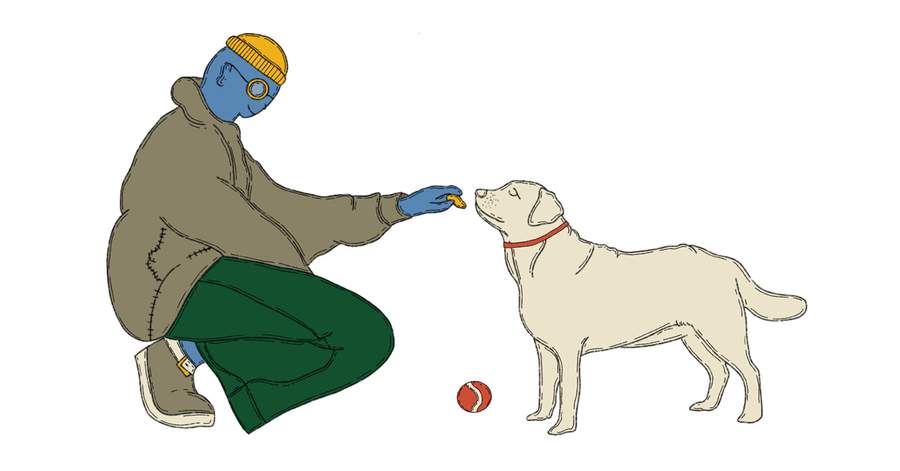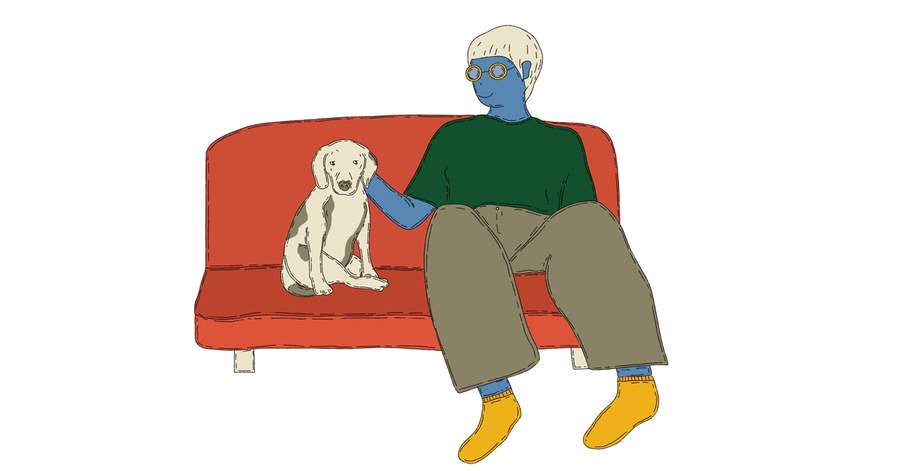Deeper Read: The Science Behind Human-Canine Friendships
Humans enjoy a whole lot of health and emotional benefits from interacting with pooches. Kate Leaver, journalist and author of the book Good Dog, tells Uncommon Sense host Amy Mullins about some of the research on our unique connection with canines.
WORDS AMY MULLINS
ILLUSTRATIONS ERIN STEVENS
Dogs bring us closer to ourselves. They ground us in the physical world when we get caught up in our own thoughts. They comfort us when we are experiencing pain or sadness, and they lift us up with seemingly endless affection when we see them. It’s hard not to smile and feel joy when you’re greeted with a wagging tail, a few licks on your hand, and an exuberant “dog smile”.

Illustration by Erin Stevens
These are experiences any person who has a canine best friend will likely understand. However, I wonder if you have also noticed, particularly during the COVID-19 lockdowns here in Victoria, that dogs have brought us closer together? Like many in lockdown, going out for a daily walk became a relatively exciting event. Walking with my best friend Barny a golden-labrador was not only relaxing and fun, but it also started a number of socially distanced conversations.
Now, you should know that Barny is a fun-loving, social, gentle, wise and intelligent dog. Truly. He has a special talent for attracting pats and attention wherever he goes. What I’ve learned from this pandemic is that we need human connection and friendship. I also think we need nonhuman animal connection and friendship, too. Yes, dogs become family members, but they are also our friends and our confidantes. My interview with Kate Leaver brought together all of these thoughts to show just how special dogs are and how lucky we are to have them in our lives. I hope you enjoy this edited extract.

Illustration by Erin Stevens
Amy Mullins: If I have a moment of sadness, [my best friend Barny the labrador will] walk across the room and sit right next to me [or] in front of me, looking up at me, putting his head on my knees. There’s that unspoken, deep connection; it feels like you have a soulful closeness with a dog. What is some of that hypothesising around why a dog might be able to do that?
Kate Leaver: I’m not surprised at all that Barny behaves like that; I think it’s beautiful.
There are two things I would mention. One: I had this long-standing theory that my dog can smell depression on me, which sounds outlandish, but may be true.
We don’t know for sure, [because] there’s not been enough research on it, but it’s entirely possible; dogs can smell Parkinson’s disease, and they can really effectively smell certain types of cancer, as well as malaria. Some of our most reliable diagnostic tests are to get a dog to sniff out those types of illnesses. So it follows that perhaps depression has its own smell that we as humans can’t necessarily detect; perhaps that’s how he knows something’s wrong.
Additionally, it could be that my body language changes when I’m upset, perhaps I’m slumping more or moving around the house more slowly, and perhaps he picks up on that.
The second thing I would mention is that there was a lovely study done that basically concluded that dogs are capable of basic empathy – not only for their own species, but for the human species. They did a set of experiments where they played certain noises to a dog and then monitored their reactions. Some of those noises were neutral noises, like the sound of an insect buzzing or the sound of a river rushing; others were negative or positive, like the sound of a woman crying, a dog in pain, a man laughing, and a dog being happy.
They looked at the reactions in those dogs and [they] did become distressed when they heard those negative noises in both the humans and the dogs – so the researchers do think that dogs are capable of empathy.
I’ve heard stories about people whose dogs have put their head exactly at the point [of the] break in their leg, because they detect that something’s wrong there, and dogs who stay by someone’s side throughout the entire recovery period from cancer treatment. It’s quite remarkable.

Illustration by Erin Stevens
I was thinking about those neurological conditions like a stroke, where people might lose their ability to speak – and so that kind of unspoken interaction is even more important.
Absolutely. I spoke to a man whose dog spent a lot of time with stroke patients in a hospital. There’s no requirement for them to have a conversation; they don’t have to explain themselves; they don’t even have to answer the question of, “How are you feeling?” There’s just a wordless, conditionless affection and love there, which can be precisely what someone in that position needs.
Sometimes it’s wonderful to talk, but sometimes you just need to be in the silent presence of a loving creature – and that’s where dogs can be wonderful, because they’re never going to ask you any complicated questions or require much from you apart from a little pat and maybe a treat.
It reminds me of my nan who had a dog towards the end of her life. He was a shelter dog and she had dementia. [He] would be her companion that she could speak with. She certainly didn’t expect him to answer back, but she could at least verbalise and just say things.
They can be remarkably helpful for people in your grandma’s situation.
There are several stories in the book about a schnoodle who worked in a dementia ward. That dog had this way of bringing someone who has dementia back to themselves, back to their younger self, in a period where they had had a pet.
There was an example of an elderly woman who used to work as a vet. They brought the dog in and she instantly went back into vet mode and said, “Well, what’s wrong with this dog, let me have a look.” It was like [the dog] woke her from the sort of slumber you can feel you’re in when you have dementia.
There was another beautiful example of a woman who hadn’t spoken in 12 weeks – not a word. Then, when this dog jumped on her bed, she started telling a story about another time she’d had a dog.
I think [having a dog] probably kept [my grandmother] alive for many more years than she would have had without him, so it can be the most wonderful solace, particularly for elderly people who can be lonely no matter what their medical condition may be.

Illustration by Erin Stevens
[In the book] you talk about a Japanese study from 2015 on the levels of oxytocin that occur in dogs and humans. I wonder whether you can share with us the kind of insights that came from that study.
Basically, this researcher conducted a study because he had his own two standard poodles and wanted to know more about his relationship with them. He invited a whole bunch of people in with their dogs and also, for control, some people who had pet wolves.
He took urine [samples] to look at their levels of oxytocin, that lovely hormone we often call the “hug hormone” or “cuddle hormone”, [which] makes us feel trusting and loved [and] helps us bond with our parents when we’re babies.
[The researcher] asked them to stay in a room with their dog and make as much eye contact with their dog or wolf as possible throughout a 30-minute period. Then, he would take their urine test again to test whether their oxytocin levels had increased at all and the results were really interesting.
For human beings who had dogs, their oxytocin levels increased by 300 per cent. For the people who had wolves, there was no effect.
The dogs had a 130 per cent increase in oxytocin, as well.
So it truly is a mutual thing, reciprocal between humans and their pets.
It’s nice to hear that the dogs also [experience a beneficial] effect; it’s not just all take.
Exactly.
It did make me think that you can’t really get angry at your dog if they drop their slobber-covered toy at your feet for you to throw it again because actually you’re getting something out of it more than they are, mathematically.
It’s true. Apparently they [also] get a hit of endorphins when they lick you. Which explains [why] my dog is just obsessed with trying to lick us. I suspect it may also be a form of affection, but who knows.
Amy Mullins is the presenter of Uncommon Sense on Tuesdays from 9am until noon. It features long-form interviews about politics and current events, international affairs, history, art and the natural world. Amy is a former not-for-profit executive, now historian-in-training, public speaker and writer. Erin Stevens is a local illustrator and designer. Find her over on Instagram @_erin.designs. This article first appeared in Triple R’s subscriber magazine, The Trip.